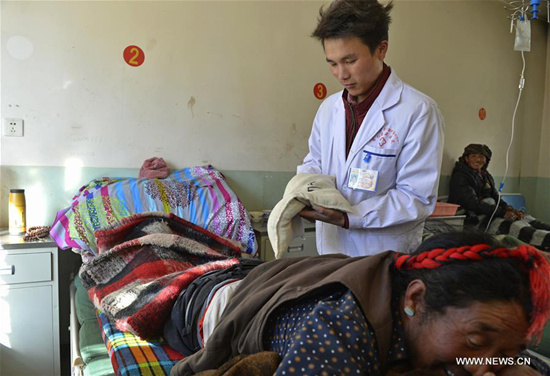By Tom McGregor, CCTV.com Panview commentator and editor
Tibetan Medicine (TM) is considered an offspring of Chinese Medicine, along with connections to traditional Indian and Arabic cures. TM offers unique features in its treatment, since the herbs used are grown in high-altitude, dry and frigid climates.
TM has a rich 2,300 years history and practitioners keep searching for innovations and have implemented Western medical equipment to upgrade treatment methods.
Doctors rely on a book, "Four Volumes of Medicine" (FVM) with 156 chapters and first published in 1546 AD, which is the most systematic and complete book for TM.
UNESCO (United Nations Educational Scientific Cultural Organization) has awarded TM as a national intangible cultural heritage in 2006. Accordingly, TM has widened its appeal in China and abroad, while practitioners are introducing innovations to make cures more effective.
Rise in popularity
Dr. Renwang Cering, who was born in the Tibet Autonomous Region, had studied TM for 15 years before starting work at the Tibetan Medical Hospital in Lhasa in 1995. He transferred to Beijing Tibetan Medicine Hospital, founded in 1992, where he has risen in ranks to vice president.
"In the 1990s, only a select few people would come and visit Tibetan medicine doctors," Dr. Renwang told Beijing Review magazine. "Now we see many more patients coming in for treatment."
He added, "Some are diagnosed with terminal diseases and see no hope with Western medical treatment. They bet on the possibility that TM might have some mysterious power and wish for it to create a miracle."
However, TM should never be viewed as the cure-all for every disease.
Overcoming unexpected difficulties
TM seems most suitable for patients living in Tibet, since they have had a long history of using herbs grown in the region.
TM frequently treats patients suffering from liver ailments, kidney diseases, digestive, cardiovascular and rheumatoid arthritis. Doctors are trained to observe a patient’s urine to make a diagnosis and treatment. They look at the urine’s color, foam, smell and sediment.
Practitioners are required to maintain top-notch standards and are expected to prescribe medicines that have performed well under quality evaluation standards. Nonetheless, many herbs used, such as 'Mirabalis Himlaica' remain endangered.
"They are endangered owing to the very specific conditions needed for their growth, but are widely used in clinical practice," said Dr. Nie Lijuan, professor at the School of Medicine at the University of Tibet in Lhasa.
Growing herbs via industrialization
Many herbs are grown in Qushui County, Tibet Autonomous Region, but the growing season is short and scientists have embarked on building laboratories and greenhouses to replicate atmospheric conditions needed for herbs to sprout.
The TM Hospital in Lhasa, opened in 1916, has expanded the Biological Research Institute of TM (BRITM) to cultivate and raise herbs indoors.
BRITM has grown 27 endangered herbs under artificial conditions over the past decade. The lab is home to a variety of equipment, including germinators, climate incubators and imaging systems.
"To meet the rising demand for TM, artificial cultivation of herbs is a must," Dr. Tashi Tsering, director of BRITM told China Daily.
Even in ancient times, Buddhist monks serving as TM practitioners had sought innovations and adapted to contemporary conditions to improve treatments.
TM doctors were performing brain and cataract surgeries, 1,000 years ahead before Western doctors were found at the operation table.
Subsidized support from Beijing
From 2014 to 2016, Beijing has handed over RMB256 million (US$38 million) in subsidies to the TM Hospital and R&D departments in Lhasa, according to Soinam, head of medical development at the hospital's traditional herb process.
Botanists have succeeded in transplanting home-grown herbs from the workshops to labs for experiments. The overall strategy is to convert them into granules, instead of pills, since they are more popular with patients.
Manufacturers that utilize ingredients from TM-related herbs, minerals, insects and animals in order to treat afflictions have witnessed rapid growth in the sector.
Phurbu Drolma, director of Tibet Autonomous Region Health and Family-planning, told China Radio International (CRI) that his department promotes the industrialization of TM.
In 2014, full-year industrial output of TM had exceeded RMB800 million (US$126 million). As of October 2015, 18 Tibetan companies are ‘Good Manufacturing Practice’ certified, meeting China’s standards for the Food and Drug Administration.
Winning with strength and resilience
"TM as we know it today has absorbed medical knowledge from China, India and Persia to create something unique from the sum of its parts," Stephan Kloos, research fellow at the Austrian Academy of Science, told Xinhua.

(A doctor treats a patient with hot compress therapy using a woolen bag of salts in the Ngamring Tibetan Hospital, in Ngamring County, southwest China's Tibet Autonomous Region, Nov. 3, 2016. Tibetan medicine has absorbed the influences of traditional Chinese, Indian and Arab medicine and is mainly practiced in Tibet and the Himalayan region. It uses herbs, minerals and sometimes insects and animal parts. Photo from Xinhua)
He added, "Its very strength, resilience and dynamism derive from centuries of exchanges between practitioners and scholars from diverse backgrounds."
Kloos pointed out a significant factor to China's success story in developing groundbreaking inventions and innovations in the science, technology and medical fields.
Chinese scientists have received international cooperation to advance to higher levels. Accordingly, global cooperation should play a more supportive role to accomplish amazing deeds in the fields of science and technology.
(The opinions expressed here do not necessarily reflect the opinions of Panview or CCTV.com. )

Panview offers a new window of understanding the world as well as China through the views, opinions, and analysis of experts. We also welcome outside submissions, so feel free to send in your own editorials to "globalopinion@vip.cntv.cn" for consideration.
















